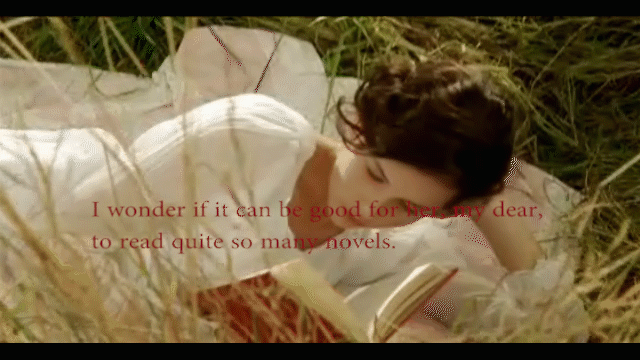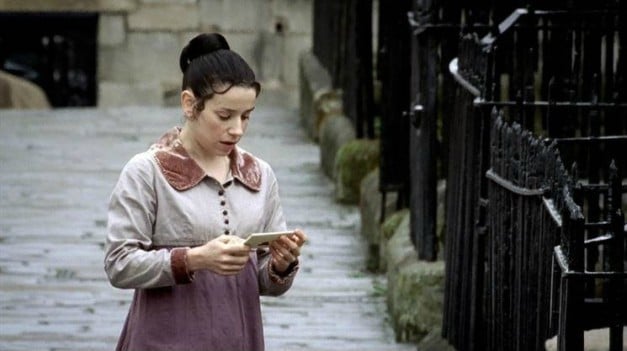Six months after Jane Austen’s death, the first book EVER listing Jane Austen as its author was published. Persuasion and Northanger Abbey – a four-volume work – hit the market in late December 1817, although the title page lists 1818 as the publishing year. So here they were, two of Austen’s heretofore unpublished works, two completed novels by the master’s hand published together, and the first to ever openly name Jane Austen as their author. During her lifetime, all of Austen’s works were published anonymously, variously “By a Lady” or “By the Author of …”
RELATED: 50 BOOKS TO READ IF YOU LOVE JANE AUSTEN
In many ways, the novels are apt bookends to Austen’s authorship. Northanger Abbey is one of Austen’s early works, a novel she’d already been working on during the 1790s, the same period that she was writing Sense and Sensibility (her first published novel) and Pride and Prejudice (her second published novel). In fact, Northanger Abbey was the first novel Jane Austen submitted for publication back in 1803. She sold the publishing rights to a bookseller, who never did publish it, just sat on it, refusing to return it and threatening legal repercussions should Austen seek publication elsewhere. Eventually, the publisher relented and said that Austen could purchase the rights back. In 1816, her brother did just that, and Austen edited it extensively before her death, including changing the main character’s name from Susan to Catherine.
RELATED: WHAT’S IN YOUR FAVORITE AUSTEN HEROINE’S NETFLIX QUEUE? GUEST POST BY AUTHOR JILLIAN KUHLMANN
And then there’s Persuasion, the last completed novel by Jane Austen, with a heroine a full decade older than the youthful one of Northanger Abbey. Catherine Morland is in full bloom, while Anne Elliot has lost her bloom. Catherine has a head full of fancies and follies. Anne is all level-headed, duty-bound and pragmatic. And man, do I love these two!
Catherine

“She had three sons before Catherine was born; and, instead of dying in bringing the latter into the world, as anybody might expect, she still lived on—lived to have six children more—to see them growing up around her, and to enjoy excellent health herself. A family of ten children will be always called a fine family, where there are heads, and arms, and legs enough for the number…”
Northanger Abbey is essentially a parody of the Gothic romance novel, which was immensely popular during Austen’s lifetime. Catherine Morland is a bright-eyed ingenue, who is invited to Bath as a companion to the older Mrs. Allen. Catherine is just seventeen, has never before left home, so she is full of excitement and trepidations at the social prospects in Bath.
She is a naïve girl, with a head filled with heady romances and a heart filled with goodness. In Bath, out of her protective bubble, she comes to meet some rather duplicitous folk, who say one thing and mean and do another. This she does not understand. For all her youthful silliness, Catherine is a forthright young woman, who always speaks with integrity and sincerity. She’s a good girl.
RELATED: NORTHANGER ABBEY (2007): A FEAST OF COY SMILES AND CHARMING SMIRKS
So, Northanger Abbey follows this good girl’s education, as she is exposed to the darker sides of human nature and must learn to decipher between truths and half-truths and lies. She must learn to say no and stand up for herself and put her foot down. She must learn when to put the book down and stop entertaining fantastical follies. Indeed, Catherine does a lot of growing up in Northanger Abbey. She jumps to some rather ridiculous conclusions but owns up to her foibles and follies. And she falls in love along the way.
Henry Tilney is a clever clergyman, astute and observant of human nature. And it’s his family that owns Northanger Abbey. He’s a bit Mr. Knightleyish with our Catherine sometimes, chastising, teasing, teaching. He’s never been one of my favorite Austen romantic leads, but that all changed with JJ Feild in the 2007 screen adaptation. I love Mr. Feild’s Mr. Tilney – he has such an understanding of muslin (to quote from the movie!).
Anne

I know Miss Lizzie Bennet of Pride and Prejudice is often considered by many as the greatest of Jane Austen’s heroines, what with her rapier wit and epic toe-to-toe wordy knockdowns. But for me, it’s always been Anne Elliot. Lizzie may well be what I wish I could have been when I was young, while Anne is just more identifiable to me as a woman, as a middle child, as I’ve always been.
Anne Elliot is dutiful, longsuffering, pragmatic, compassionate. Mother long dead, middle-child Anne attempts to be the grounding, pragmatic force in an aristocratic family with a vain, superficial father and equally vain and superficial sisters. Sir Walter is a snob who lives well beyond his means, so much so that he must be persuaded to give up the family home, Kellynch Hall, to leasers in order to generate extra income and pay off debts. He and the eldest Miss Elliot relocate to Bath, sending Anne to her younger sister’s home in a neighboring village.
RELATED: DECLARATIONS OF LOVE: 8 BREATHTAKING MOMENTS IN LITERATURE
The new leasers of the Elliot estate are none other than the sister and brother-in-law to one Captain Frederick Wentworth – Anne’s great long-lost love – who just happens to be on furlough. Anne and Capt. Wentworth fell in love years prior. He proposed. And a young Anne was persuaded by her motherly surrogate, her neighbor and good friend, Lady Russell, to reject the proposal as imprudent. Anne has never stopped loving him, has regretted the decision greatly in the ensuing years. Her bloom is gone, all proclaim. She is now destined for spinsterhood.
And yet, the love of her life has just walked back into her life, and maybe there’s a second chance at love. If she can cast off some of the stifling bonds of propriety and start staking claims on behalf of herself and her own happiness.
“I can listen no longer in silence. I must speak to you by such means as are within my reach. You pierce my soul. I am half-agony, half-hope. Tell me not that I am too late, that such precious feelings are gone for ever. I offer myself to you again with a heart even more your own than when you almost broke it, eight years and a half ago. Dare not say that man forgets sooner than woman, that his love has an earlier death. I have loved none but you…”
Oh, yeah, and there’s like the greatest love letter ever written!
200 Down and Surely Many, Many More To Go
While there is great pleasure in reading a good book, there is also pleasure to be found in a good screen adaptation of a good book. Both Northanger Abbey and Persuasion have had screen adaptations made: two for Northanger Abbey and four for Persuasion.
The BBC and A&E adapted Northanger Abbey in 1986 with Katharine Schlesinger and Peter Firth as the romantic leads. ITV followed nearly two decades later in 2007 with their version, starring Felicity Jones and JJ Feild, with a screenplay by the much-heralded Andrew Davies. It is this latter version which is a personal favorite of mine. I have watched it and re-watched it aplenty, and it never ceases to please.
RELATED: A CASE FOR ENJOYING NORTHANGER ABBEY (1986)
The BBC and ITV have alternated in their screen productions of Persuasion through the years. The BBC started it off in 1960 with a miniseries starring Daphne Slater and Paul Daneman. ITV presented their version in 1971, starring Ann Firbank and Bryan Marshall. There would then go over two decades before the BBC aired a made-for-TV movie with Amanda Root and Ciáran Hinds as the romantic leads. ITV then presented their new Persuasion in 2007, a version starring Sally Hawkins and Rupert Penry-Jones. It is these two latest versions with which I am most familiar; the 1995 version being a personal favorite.
RELATED: PERSUASION (1995) REVIEW – FAITHFUL ADAPTATION OF JANE AUSTEN’S ENDURING CLASSIC
So, why not celebrate the 200th anniversary, well, technically we’re nearly the 201st anniversary of Persuasion and Northanger Abbey by giving the books a read or a re-read. Or, at the very least, watching one of the screen adaptations and just smiling and sighing.
Long live Catherine Morland and Mr. Tilney and Anne Elliot and Captain Wentworth! I expect they’ll still be read 200 years from now. And think of the all the adaptations that could come in the course of 200 years! I’ll keep watching my share as long as I’m ticking.
RELATED: FOR DARKNESS SHOWS THE STARS: A DYSTOPIAN RETELLING OF JANE AUSTEN’S PERSUASION
Are you a fan of Catherine and/or Anne? Share your thoughts on Northanger Abbey and Persuasion in the comments.
ARE YOU A ROMANCE FAN? FOLLOW THE SILVER PETTICOAT REVIEW:
 Our romance-themed entertainment site is on a mission to help you find the best period dramas, romance movies, TV shows, and books. Other topics include Jane Austen, Classic Hollywood, TV Couples, Fairy Tales, Romantic Living, Romanticism, and more. We’re damsels not in distress fighting for the all-new optimistic Romantic Revolution. Join us and subscribe. For more information, see our About, Old-Fashioned Romance 101, Modern Romanticism 101, and Romantic Living 101.
Our romance-themed entertainment site is on a mission to help you find the best period dramas, romance movies, TV shows, and books. Other topics include Jane Austen, Classic Hollywood, TV Couples, Fairy Tales, Romantic Living, Romanticism, and more. We’re damsels not in distress fighting for the all-new optimistic Romantic Revolution. Join us and subscribe. For more information, see our About, Old-Fashioned Romance 101, Modern Romanticism 101, and Romantic Living 101.
